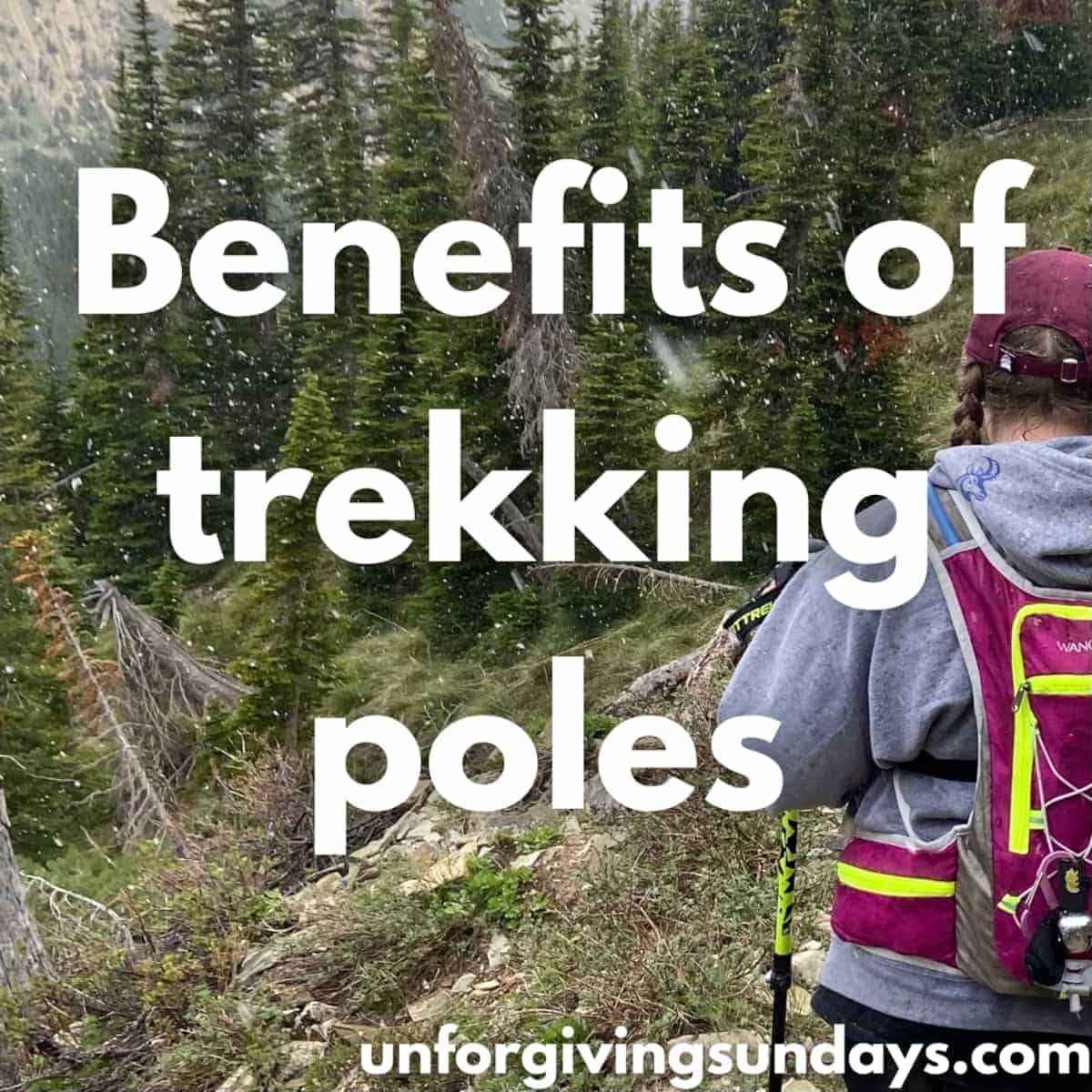Walking poles, hiking poles, trekking poles — whatever you want to call them, they can be a handy addition for any mountain adventure. In case you need convincing, here are all the benefits of walking sticks for hikers.

What are trekking poles?
Trekking poles are adjustable poles that are used to enhance hiking ability, essentially giving the user a third and fourth leg — that means more stability, more endurance, and more wilderness. They go by many names (trekking poles, hiking sticks, hiking poles, walking sticks, walking poles, etc.).
Trekking poles vs. ski poles
Ski poles are a fixed length. One of the benefits of hiking poles is that they can be adjusted for the slope — when heading uphill, you might want to shorten your poles; when heading downhill, you might want to lengthen them.
Why use walking sticks?
There are lots of benefits to walking sticks. Here are a couple of benefits that trekking poles could bring to your next hike.
Improved balance and stability
If you’ve ever walked down the street with me then you know that I am not the most coordinated person. The reason I love trekking poles is that they keep me more upright than I would be on my own. Don’t get me wrong, they aren’t magic and I will still spend some part of the hike on the ground, but it’s an improvement.
Hiking poles are great for navigating difficult terrain because they help maintain balance and improve stability by having a third point of contact with the ground. Because of this, trekking poles are incredibly handy for trails that are steep, slippery, or uneven.
Poles are helpful when ascending or descending — whether you are using them to pull yourself up on the uphill or prop yourself on the downhill.
Reduced impact on joints
Hiking poles can reduce the impact on your joints by helping to distribute weight. This is especially important when headed downhill, as the poles will help absorb some of the impact.
You’ll actually burn more calories using poles because your arms are working more. Not only are your arms moving more, weight is being transferred to your arms, taking some of the work off of your legs, which reduces fatigue and allows you to hike farther.
Walking sticks are helpful for hikers with existing joint issues, but are also going to help those without problems prevent issues from cropping up in the future.
Better hiking form
Walking sticks will help improve your posture, which really takes some of the strain off of your back — especially helpful if you are carrying a backpack. Good posture also means that you’ll be able to take fuller breaths, as your lungs aren’t restricted because you aren’t hunched over.
By regulating your walking rhythm, walking sticks ensure that your stride is more uniform and help to set a steadier (and often faster) pace. This rhythm reduces overexertion, particularly to one side of the body compared to the other.
Should I use hiking poles?
Trekking poles definitely aren’t necessary, but that doesn’t mean you won’t benefit from using them on your next adventure. If you want extra support on challenging terrain or to lessen the impacts of hiking on your body, you should give them a try.
Do you need one or two poles?
Is it better to hike with one pole or two? There is no right or wrong answer, and it definitely isn’t bad for you to only use a single hiking staff. However, although you can get a lot of the same benefits by using only one pole, most people prefer to use two.
You might choose to use just one trekking pole if you like to keep one hand free or you don’t want the extra weight.
When should I consider using walking sticks?
Anytime! But walking sticks can be especially helpful when:
- Ascending or descending
- On uneven, rocky, or loose ground
- In slippery, icy, or wet conditions
- Crossing rivers and streams
- Navigating steep terrain
- Carrying a heavy backpack
Anatomy of a hiking pole
Hiking poles are typically made of aluminum or carbon fiber. Aluminum poles are more durable but carbon fiber poles are lighter. The poles are adjustable, but you should still make sure that they adjust within the range you require. Grips are typically made of foam, cork, or rubber.
Why are there wrist straps?
The wrist straps are supposed to help with stability, but I think they are mostly there so you don’t lose your poles.
What about the tips?
A trekking pole has a metal tip that digs into the ground. If you are using poles in the snow, you can add a basket around the tip, which keeps the pole from sliding too deeply into the snow. If you are using poles on hard ground (like cement), you might want to add rubber covers over the tips to give you more traction.
How to use trekking poles
How to size trekking poles
When hiking on relatively flat ground, you want your poles to be long enough so that your elbows are bent to 90 degrees when holding the poles. For steep sections, you might want to shorten your hiking poles on the uphill and lengthen them on the down hill (~2 to 4 inches in either direction).
How to hike with walking sticks
Try not to think about it. Walk normally and place the pole down at the same time as you place the opposite foot (e.g., left foot, right pole). Move the poles so they alternate with your steps. You don’t need to dig the poles into the ground.
So, do trekking poles really make a big difference? I definitely think they help. Give them a try and tell me about it below. Already use trekking poles? Let me know where you stand in on the one-pole versus two-pole debate.




Leave a Reply